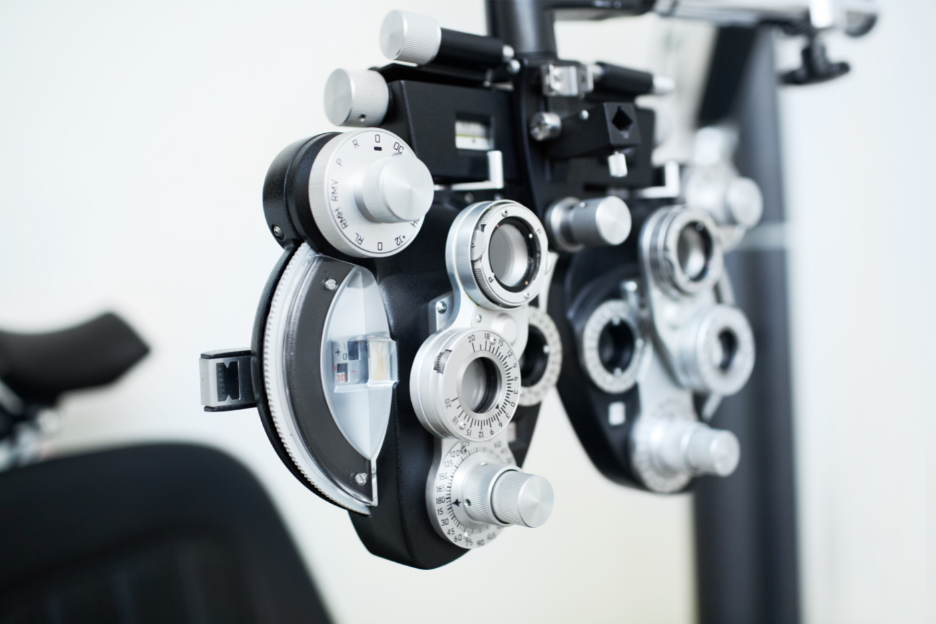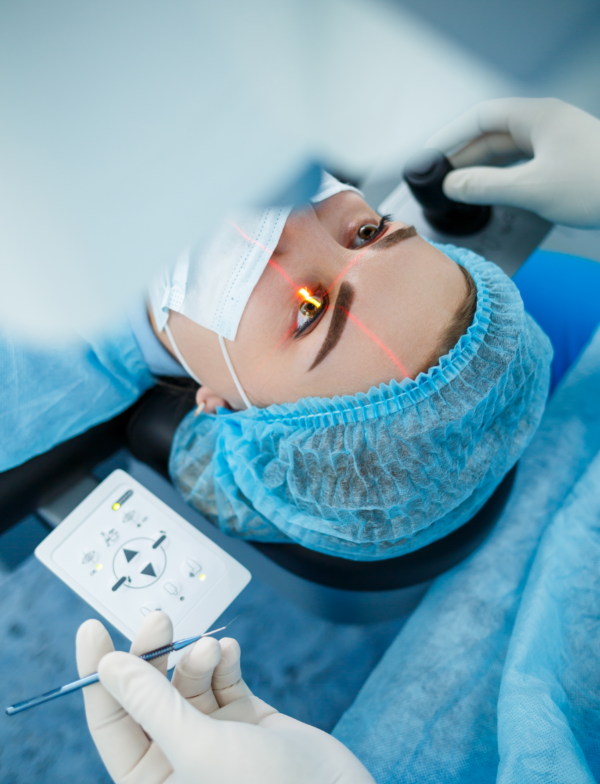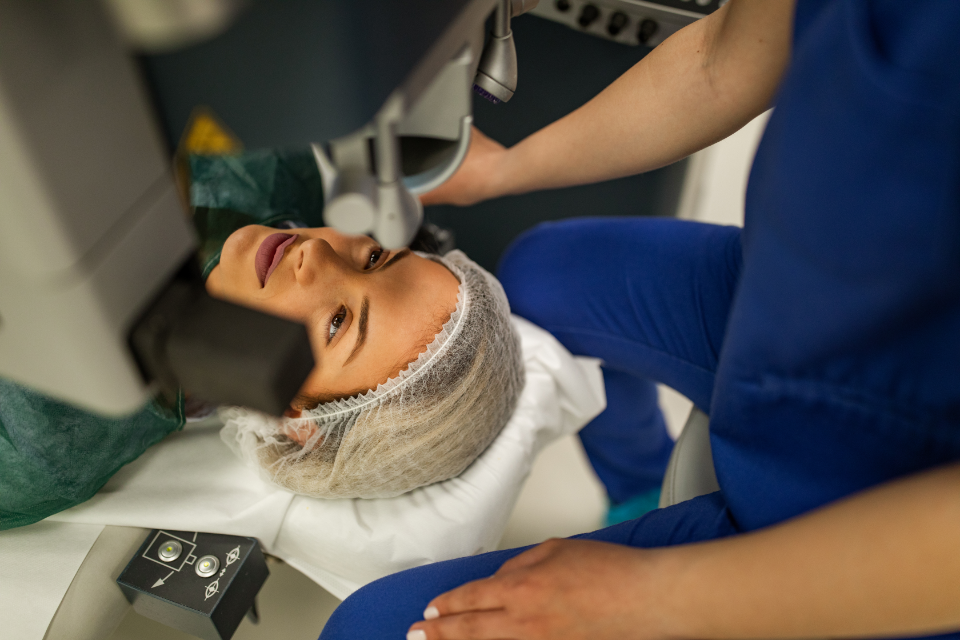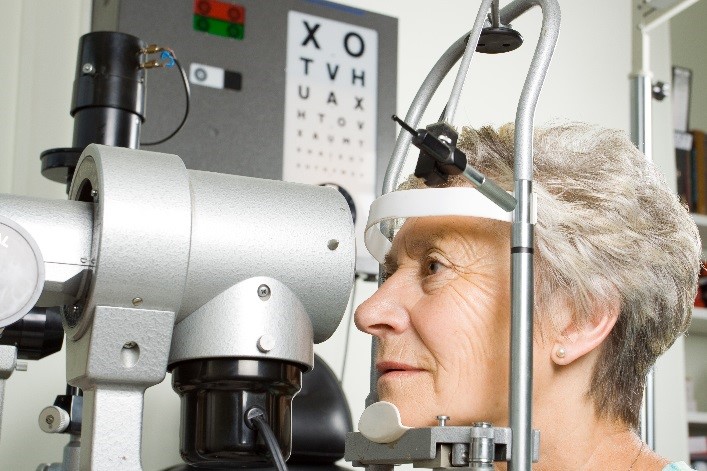Cataract Surgery Financing
All Saints Eye Center accepts CareCredit, a leading healthcare financing program. Begin your cataract surgery now and pay for it over time so it fits within your monthly budget. Check out our payment calculator and learn how to qualify for CareCredit.
Cataract Surgery at All Saints Eye Center
All Saints Eye Center has 30 years of experience delivering excellence in eye care in southwest Florida. Contact us today to schedule a consultation for cataract surgery.
WHAT ARE CATARACTS?
A cataract is a clouding of the clear natural lens of the eye. The lens is the part of the eye that acts as a window behind the iris and the pupil. Unfortunately, they occur naturally as we age and tend to impact people over the age of 40. Although age is the most common reason for cataracts, occasionally children are born with congenital cataracts and young adults can develop debilitating visual impairment from a cataract.

HOW DO I KNOW IF I HAVE CATARACTS?

Many patients with cataracts don’t notice that their vision has changed because it grows very slow over time. Generally, visual problems occur mostly as blurred vision in one or both eyes. Under certain conditions, your vision may be worse than others from your cataract. You may notice a "starburst effect", halo around headlights at nighttime, glare from lights or the sun making it harder for you to see. Color vision, as well, can be severely affected by your developing cataract.
AM I A GOOD CANDIDATE FOR CATARACT SURGERY?
You are ready for cataract eye treatment when it is interfering with your everyday lifestyle, which is different for each individuals. An elderly nursing home patient may not be as bothered by a cataract to the same degree as an active younger person. Ophthalmologists no longer use the term "ripe" when determining when cataract surgery is appropriative, instead, the surgery is generally indicated when your vision is interfering with your lifestyle and enjoyment of life. Some of the most common symptoms of problematic cataracts are
- Cloudy lenses
- Blurred vision
- Difficulty seeing both at night or during the day
- Seeing halos around lights

What To Expect When Undergoing Cataract Surgery
Cataract surgery is an outpatient procedure performed an ambulatory surgery center, not a hospital. Anesthesia services will be provided and you will be sedated and continually monitored during your procedure. You will be at the surgery center for approximately 90 minutes and average time in the operating room is approximately 10 minutes. You cannot drive for 24 hours after your surgery; however, you will likely be able to drive to your postoperative appointment the following day. No one will touch your eye except Dr. Zimm.
It is possible that 3 steps may be necessary in order for you to achieve your final desired postoperative vision. This would include, the primary cataract removal, possibly a YAG capsulotomy and lastly, a PRK laser to remove any residual nearsightedness, farsightedness, and/or astigmatism.
To determine candidacy, our team will meet with you and conduct a comprehensive eye exam to determine your vision stability, corneal thickness and eye health. If you are not a candidate for LASIK, we can recommend an alternative treatment option that addresses your vision needs.
WHAT PEOPLE SAY ABOUT US!
“My entire family goes to All Saints Eye Center. We have never had any issues with the staff or doctors and Dr. Zimm performed both my parents and sisters cataract surgeries. I actually had Lasik done by Dr. Zimm way back in 2004. Highly recommend.”
WHERE IS THE CATARACT SURGERY PERFORMED?

Your cataract surgery is performed at an outpatient ambulatory surgical center so no hospital is needed. You will typically be at the center normally for 1 1/2 hours. After you are brought into the surgical center, mild sedation is administered. Generally, Dr. Zimm employs the no-stitch cataract technique using only drops for topical anesthesia. You leave the surgery center wearing only dark glasses. No patches are needed, most of the time, you will require little or no pain medication.
HOW IS CATARACT SURGERY PERFORMED?
Cataract surgery involves Dr. Zimm making a small incision in the cornea in order to access the cloudy lens. Using a process known as phacoemulsification, Dr. Zimm will insert a small probe in your eye. Ultrasound waves break up the cataract and a vacuum is used to suction the fragment pieces out. After the cataract is removed, Dr. Zimm will insert an IOL (intraocular lens implant) to replace the lens. The incision is so small, you will not need any stitches on your eye and the incision should heal naturally.

CATARACT SURGERY TECHNIQUES
Traditional - In standard cataract surgery, all the incisions are made manually by Dr. Zimm using a diamond blade.
Laser (LenSx) or bladeless cataract surgery - In this technique, a computer guided laser is used to make all the incisions for cataract surgery, no blades are used. Dr. Zimm programs the laser to take into account the uniqueness of each individual patient's eyes and he adjust the setting appropriately to deliver the most precise incisions. The laser also has one distinct advantage over the traditional surgical technique... it will fragment the cataract. In other words, the laser system, using minimal energy will fragment the cataract into small pieces allowing the surgeon to extract the cataract using less energy and in a shorter period of time.
Which technique does Dr. Zimm suggest?
"Both traditional and bladeless cataract surgery yield excellent results; however, as a surgeon who has performed over 30,000 cataract procedures, I would definitely say that there is no surgeon that can match the precision and accuracy of a computer guided laser."
Multifocal Intraocular Lenses (IOLs)
Multifocal IOLs are able to restore visual function and allow freedom from glasses and contacts after implantation with great levels of patient satisfaction. Multifocal intraocular lenses have gained widespread acceptance since 2005 and the popularity of multifocal intraocular lenses is increasing every year. These intraocular lenses typically give patients good distance, intermediate and near vision without the use of glasses. Therefore, patients are often using only over-the-counter sunglasses and reading glasses (if patients are interested in additional magnification). It is important to note that these implants will improve the clarity of the images; however, they are not magnifiers. By the laws of physical optics, magnification can only be achieved through the use of a magnifying glass. All Saints Eye Center uses a variety of multifocal intraocular lenses and approximately 70% of Dr. Zimm’s patients are selecting these multifocal intraocular lens for their cataract surgery. The staff at All Saints Eye Center will go over, in great depth, which multifocal intraocular lens is appropriate for you and your lifestyle. These lenses are also available with astigmatism correction if necessary.
Astigmatism Correction Or Toric Intraocular Lenses
All Saints Eye Center offers a variety of toric, or astigmatism correcting, intraocular lenses. These IOLs are often necessary in patients with moderate to high degrees of astigmatism. The intraoperative calculation of the astigmatism will be performed at the time of the procedure and the appropriate implant will be inserted into the eye to neutralize your astigmatism. Astigmatism correcting intraocular lenses are very commonly used at All Saints Eye Center and can give the patient extra clarity.
WHAT IS RECOVERY LIKE AFTER CATARACT SURGERY?
You are seen the day after cataract surgery. The recovery period for cataract surgery is relatively short for most people. Many people feel ready to return to work or even drive a car within a couple of days after surgery. However, occasionally swelling can occur which will limit your vision in the immediate postoperative period. Topical eye drops are used for a few weeks after the surgery and, generally, patients are seen several times after surgery. Complication rates average less than 2%. Dr. Zimm and his staff will be happy to discuss all of these factors in greater depth during your evaluation.
WHAT IS YAG LASER CAPSULOTOMY?
After cataract surgery, sometimes a YAG Capsulotomy is needed to clear the haze from your new lens. This will most likely be necessary for every patient at some point after their surgery and is a simple outpatient procedure requiring no anesthesia or drops after the laser.
SCHEDULE A CATARACT SURGERY CONSULTATION
Dr. Jeffrey Zimm is one of the most experienced cataract surgeons in the area, having removed over 30,000 cataracts in Southwest Florida. To request an appointment with Dr. Zimm or to get more information about the benefits of cataract surgery, please call (239)-592-5511 or complete an online contact form to reach one of our Fort Myers, Bonita Springs or our North Naples and South Naples, offices.

